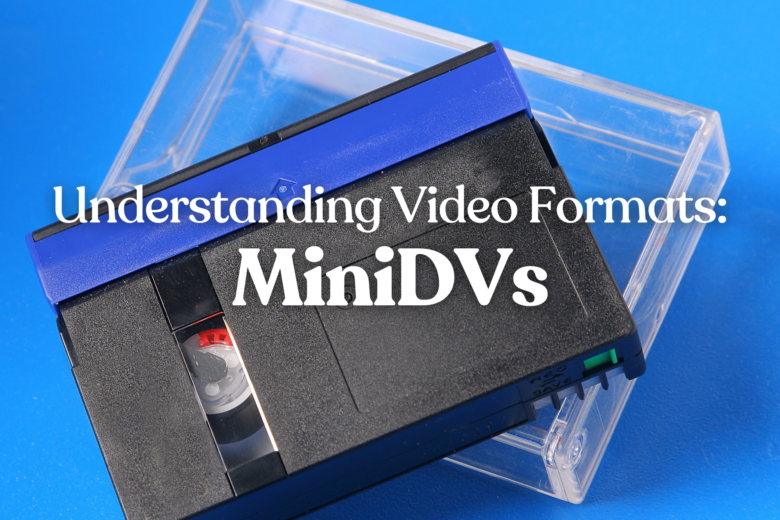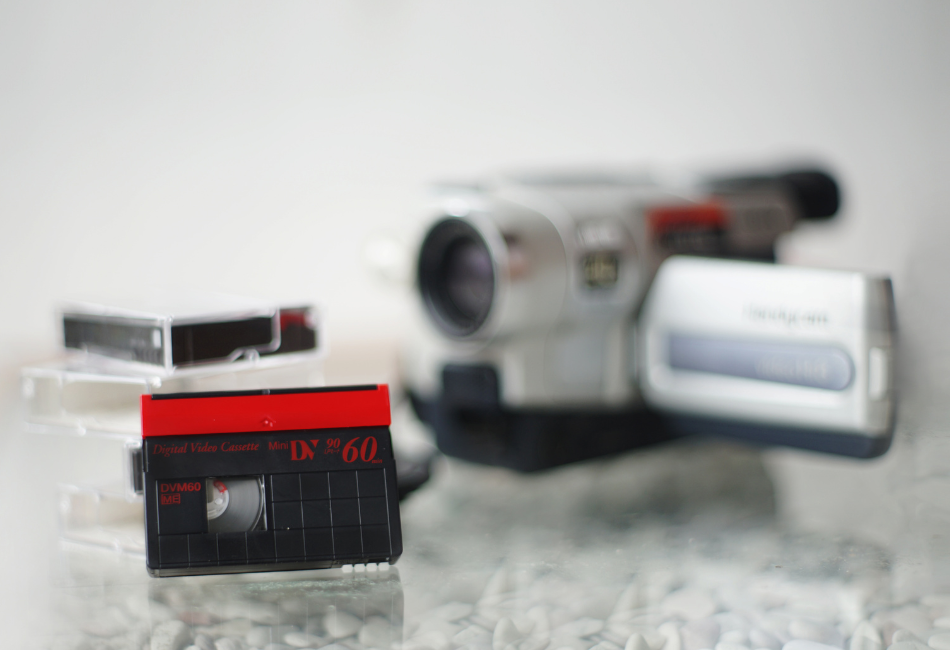In the 1990s, mini DV tapes were a cutting-edge technology in video recording. These days, they’ve been replaced by more convenient digital storage methods but many people still have precious footage preserved on mini DV tapes.
In this blog, we explore how mini DV tapes work and how you can still watch and protect your recordings today.
WHAT IS A MINI DV TAPE?
Mini DV (digital video) tapes came about in the mid 1990s, as a significant technological upgrade from analog formats like VHS. These small, rectangular cassettes store video recordings in a digital format, though still need to be run through a transfer process to be stored on a computer.
Introduced in 1995, they look like a shrunken-down VHS tape –– about 20% of the size but able to store around 60 to 90 minutes of video. Inside the plastic shell is magnetic tape on which the recording is stored.
Originally created for amateur use, the mini DV delivered clearer video quality and greater reliability compared to earlier options, so soon became an acceptable format for professional productions as well. To record, you simply inserted the tape into a camcorder, which captured both video and audio onto the digital tape. Playback was equally straightforward, as the tape could be inserted into a compatible player.
The introduction of mini DV tapes marked a major shift from analog to digital recording, providing a more precise and dependable way to capture video.
HOW DOES MINI DV WORK?
Mini DV works by recording video and audio in a digital format, as opposed to analog systems.
A mini DV camera captures the video and audio as digital information. This data is then encoded onto the magnetic tape inside the mini DV cassette. The tape moves past a recording head in the camcorder, which writes this digital data onto the tape.
When you play back the tape, the camcorder’s playback head reads the digital information from the tape and converts it back into video and audio signals, which you see on the screen. Because the information is digital, it maintains better quality and is less likely to degrade over time, when compared to analog recordings.
WHAT WERE THE ADVANTAGES OF MINI DVS?
When mini DV tapes first came to market, they were an instant hit. One of the most significant benefits was their high-quality digital recording. While previous analog formats (like VHS and 8mm) could lose clarity and detail over time, this new digital format didn’t have that issue.
Another advantage was the compact size of the tapes. Mini DV tapes were much smaller than their analog predecessors, without compromising on storage size, making them more convenient.
When they were first introduced, mini DV tapes were a revolutionary choice for filmmakers, both amateur and professional alike.
ARE MINI DV TAPES STILL MADE?
The rapid evolution of digital video technology led to the decline of mini DV tapes, so they’re no longer widely produced. Though it was a great innovation, newer formats and storage solutions emerged soon after that offered even more advantages.
It didn’t take long for formats like DVD and other digital storage solutions to surpass mini DV in terms of storage capacity, ease of use, and video quality.
SD cards soon replaced mini DV tapes as the most convenient recording and storage solution – they’re smaller, more durable, and have much more storage space. Plus, they’re easy to simply plug into a computer via an adaptor, without the need for extra hardware.
HOW DO I WATCH MINI DV TAPES?
Though mini DV tapes may no longer be the most convenient recording format, you still have a few options for watching back your old footage.
- With a camcorder: If you still have a mini DV camcorder, you can insert the tape into the camcorder and play it back directly, either on its screen or output it to a TV or monitor.
- With a DV player or deck: A mini DV player or deck is a dedicated device designed for playing mini DV tapes. These devices can be connected to a TV or monitor. Simply insert your tape and hit play.
- By digitizing your tapes: Transferring the content of your mini DV tapes to a digital format for easier access is a great way to store and protect your library. This involves connecting a mini DV camcorder or player to a computer with capture software, which converts the video from the tape into a digital file format.
This way, you can store, edit, and view the footage on your computer or other digital devices. The best way to do this is with a digitizing service like EverPresent.
DO MINI DV TAPES DETERIORATE?
Mini DV tapes can deteriorate over time. While they are more durable than some older analog formats, they are not immune to wear and tear. On average, they usually only last about 25 years in pristine condition. So if your recordings are from the 1990s, the clock is ticking if you want to restore them.
Over time, the magnetic tape can suffer from physical wear from repeated use or improper storage. If the tape stretches, frays or the video heads become clogged, then the picture and sound could drop out during playback.
Also, if the cassette shell becomes damaged, it may not play in a camcorder or deck.
CONVERT YOUR MINI DV TODAY
If you have valuable content on mini DV tapes and want to preserve it for the future, EverPresent offers professional digitizing services.
We transfer your mini DV tapes to digital files, ensuring that your footage is safely converted into a format that’s easy to store, share, and enjoy. Get in touch to protect your memories from deterioration and keep them accessible for years to come.




